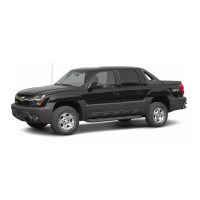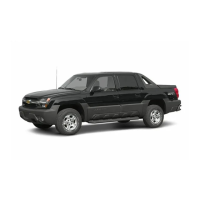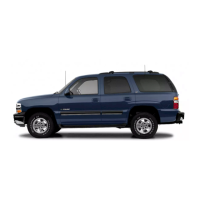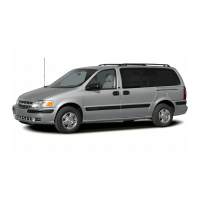Do you have a question about the Chevrolet 2004 Astro and is the answer not in the manual?
Details on manual and power seat adjustments, including lumbar support and seatback latches.
Guidance on proper safety belt usage for all occupants, including children and pregnant women.
Information on selecting and using child restraint systems for different age groups.
Explanation of the air bag system, its operation, and safety precautions.
Details on manual and power door locks, including security features and leaving the vehicle.
Explanation of the Passlock® theft-deterrent system and its operation.
Guidance on new vehicle break-in, ignition positions, and starting the engine.
Details on shift lever positions (Park, Reverse, Neutral, Drive) and their functions.
Diagram and labeling of the main components of the instrument panel.
System for controlling heating, cooling, and ventilation for the vehicle.
Explanation of warning lights, gages, and indicators on the instrument panel.
Function of the air bag readiness light and system checks.
Indication of potential brake system problems.
Function of the ABS warning light and what it indicates.
Explanation of the 'Service Engine Soon' or 'Check Engine' light.
Operation and features of the vehicle's audio system, including radio and CD player.
General advice on defensive driving and safe driving practices.
Principles and techniques of defensive driving for accident prevention.
Information on the dangers and effects of driving under the influence of alcohol.
Explanation of the systems (brakes, steering, accelerator) controlling vehicle movement.
Details on braking action, perception time, reaction time, and stopping distances.
Understanding and avoiding vehicle skids, including types and handling.
Safe driving practices for wet conditions, including hydroplaning and puddles.
Tips and precautions for safe driving during winter conditions.
Guidelines for determining vehicle capacity weight and proper loading.
Step-by-step instructions for safely changing a flat tire.
Recommendations for fuel type, octane, and additives for optimal vehicle performance.
Guidance on selecting the correct gasoline octane rating for the engine.
Procedure and safety precautions for refueling the vehicle's fuel tank.
Guidance on inspecting engine components and fluids for proper operation.
Instructions for checking and adding engine oil, including type and capacity.
Guidelines for checking and changing automatic transmission fluid.
Information on the cooling system, coolant type, and adding coolant.
What to do if the engine overheats, including steam warnings.
Checking and maintaining power steering fluid levels.
Information on windshield washer fluid type, use, and adding fluid.
Details on brake fluid, brake wear, and system inspection.
Proper type of brake fluid and precautions when adding it.
Identifying worn brake pads and the meaning of the brake wear warning sound.
Information on the vehicle's battery, including maintenance and replacement.
Step-by-step guide for safely jump-starting the vehicle's battery.
Instructions for inspecting and replacing windshield wiper blade inserts.
Information on tire quality, maintenance, and safety precautions.
Guidance on selecting new tires, including size, TPC Spec, and construction type.
Correct tire inflation pressures and how to check them.
Overview of the maintenance schedule, requirements, and environmental considerations.
Details on scheduled maintenance services and their recommended mileage intervals.
Specific maintenance tasks and intervals for short trip/city driving conditions.
Specific maintenance tasks and intervals for long trip/highway driving conditions.
Summary of maintenance services for short trip/city driving up to 100,000 miles.
Owner-performed checks and services for vehicle safety and dependability.
Procedure for checking the engine oil level and adding oil if necessary.
Procedure for checking the engine coolant level and adding coolant.
Checking the windshield washer fluid level and adding fluid.
How to visually inspect and check tire inflation pressure.
Ensuring safety belts, buckles, and air bag systems are functioning correctly.
Dealer-performed inspections for various vehicle systems.
Inspection of brake lines, hoses, pads, rotors, and calipers.
List of recommended fluids and lubricants for proper vehicle maintenance.
Information on customer support, satisfaction procedures, and online resources.
Steps for resolving concerns with dealership sales or service departments.
Details on roadside assistance services available during the warranty period.
Procedures for reporting safety defects to government agencies and General Motors.
How to inform NHTSA about vehicle safety defects.
How to notify Transport Canada about vehicle safety defects.
How to report safety defects directly to General Motors.
Details on manual and power seat adjustments, including lumbar support and seatback latches.
Guidance on proper safety belt usage for all occupants, including children and pregnant women.
Information on selecting and using child restraint systems for different age groups.
Explanation of the air bag system, its operation, and safety precautions.
Details on manual and power door locks, including security features and leaving the vehicle.
Explanation of the Passlock® theft-deterrent system and its operation.
Guidance on new vehicle break-in, ignition positions, and starting the engine.
Details on shift lever positions (Park, Reverse, Neutral, Drive) and their functions.
Diagram and labeling of the main components of the instrument panel.
System for controlling heating, cooling, and ventilation for the vehicle.
Explanation of warning lights, gages, and indicators on the instrument panel.
Function of the air bag readiness light and system checks.
Indication of potential brake system problems.
Function of the ABS warning light and what it indicates.
Explanation of the 'Service Engine Soon' or 'Check Engine' light.
Operation and features of the vehicle's audio system, including radio and CD player.
General advice on defensive driving and safe driving practices.
Principles and techniques of defensive driving for accident prevention.
Information on the dangers and effects of driving under the influence of alcohol.
Explanation of the systems (brakes, steering, accelerator) controlling vehicle movement.
Details on braking action, perception time, reaction time, and stopping distances.
Understanding and avoiding vehicle skids, including types and handling.
Safe driving practices for wet conditions, including hydroplaning and puddles.
Tips and precautions for safe driving during winter conditions.
Guidelines for determining vehicle capacity weight and proper loading.
Step-by-step instructions for safely changing a flat tire.
Recommendations for fuel type, octane, and additives for optimal vehicle performance.
Guidance on selecting the correct gasoline octane rating for the engine.
Procedure and safety precautions for refueling the vehicle's fuel tank.
Guidance on inspecting engine components and fluids for proper operation.
Instructions for checking and adding engine oil, including type and capacity.
Guidelines for checking and changing automatic transmission fluid.
Information on the cooling system, coolant type, and adding coolant.
What to do if the engine overheats, including steam warnings.
Checking and maintaining power steering fluid levels.
Information on windshield washer fluid type, use, and adding fluid.
Details on brake fluid, brake wear, and system inspection.
Proper type of brake fluid and precautions when adding it.
Identifying worn brake pads and the meaning of the brake wear warning sound.
Information on the vehicle's battery, including maintenance and replacement.
Step-by-step guide for safely jump-starting the vehicle's battery.
Instructions for inspecting and replacing windshield wiper blade inserts.
Information on tire quality, maintenance, and safety precautions.
Guidance on selecting new tires, including size, TPC Spec, and construction type.
Correct tire inflation pressures and how to check them.
Overview of the maintenance schedule, requirements, and environmental considerations.
Details on scheduled maintenance services and their recommended mileage intervals.
Specific maintenance tasks and intervals for short trip/city driving conditions.
Specific maintenance tasks and intervals for long trip/highway driving conditions.
Summary of maintenance services for short trip/city driving up to 100,000 miles.
Owner-performed checks and services for vehicle safety and dependability.
Procedure for checking the engine oil level and adding oil if necessary.
Procedure for checking the engine coolant level and adding coolant.
Checking the windshield washer fluid level and adding fluid.
How to visually inspect and check tire inflation pressure.
Ensuring safety belts, buckles, and air bag systems are functioning correctly.
Dealer-performed inspections for various vehicle systems.
Inspection of brake lines, hoses, pads, rotors, and calipers.
List of recommended fluids and lubricants for proper vehicle maintenance.
Information on customer support, satisfaction procedures, and online resources.
Steps for resolving concerns with dealership sales or service departments.
Details on roadside assistance services available during the warranty period.
Procedures for reporting safety defects to government agencies and General Motors.
How to inform NHTSA about vehicle safety defects.
How to notify Transport Canada about vehicle safety defects.
How to report safety defects directly to General Motors.
| Brand | Chevrolet |
|---|---|
| Model | 2004 Astro |
| Category | Automobile |
| Language | English |












